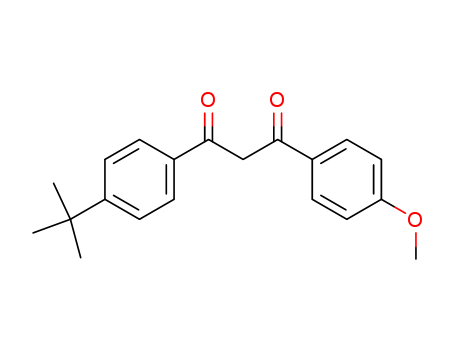

Contact Us: +86-15508631887(WhatsApp/WeChat)
Email:sales@finerchem.com
|
Properties |
Avobenzone belongs to a dibenzoyl methane derivative. It is oil soluble ingredient. Since it is very sensitive to light, photostablizers are added in the sunscreen product to increase its stability and duration of action. Avobenzone has an absorption maximum of 357 nm. Sunscreens containing avobenzone is indicated for providing protection from the sun. In addition to limiting the skin's exposure to the sun, using sunscreen agents may help reduce long-term sun damage such as premature aging of the skin and skin cancer. It is capable of blocking UVA I, UVA II and UVB wavelengths, thereby limiting the impact of UV rays on skin. Diminish the penetration of ultraviolet (UV) light through the epidermis by absorbing UV radiation within a specific wavelength range. The amount and wavelength of UV radiation absorbed are affected by the molecular structure of the sunscreen agent[15, 16]. |
|
Toxicity |
Although avobenzone itself has very low toxicity, when exposed to light in a chlorinated water solution, avobenzone can be broken down into a combination of aromatic acids, aldehydes, phenols and acetyl benzenes, several of which are highly toxic[14]. |
|
Manufacturing Process |
356.0 g (2 mol) of p-t-butylbenzoic acid, 243.0 g (7.6 mol) of methyl alcohol and 35.0 g of sulfuric acid (96%) are added to a four-necked round flask which is provided with a stirrer and a condenser. The mixture is held for 8 h at reflux temperature with slight stirring. The condenser is then replaced by a distillation column and the excess methyl alcohol is distilled off, towards the end under a slight vacuum but without the temperature exceeding 100°C. The mixture is cooled and poured on to ice. The phases are left to separate, the organic phase is washed with ice-water, with a saturated sodium carbonate solution in the presence of ice and finally with ice until neutral. The organic phase is dried over sodium sulfate and there is thus obtained a precipitate. By distillation on a Widmer column (120 mm) there are obtained 345.0 g (90% yield) of the p-t-butylbenzoic acid methyl ester, boiling point 76°C/0.02 mmHg. 2 methods of producing of 4-(1,1-dimethylethyl)-4'-methoxydibenzoylmethane from p-t-butylbenzoic acid methyl ester: 1). To a round flask which has been well dried and flushed with nitrogen are added 85.0 g (1.1 mol) of sodium amide (50% suspension in toluene) and 180.0 g of isopropyl ether and there are now added dropwise thereto at a temperature of 50°-60°C 150.2 g (1 mol) of acetylanisole in 180.0 g of isopropyl ether. Reaction sets in immediately and a white paste-like mass forms. After completion of the addition, the mixture is stirred for a further 0.5 h and then 192.3 g of p-t-butylbenzoic acid methyl ester are added rapidly at 25°-30°C. The mixture is stirred for 0.5 h at room temperature, then for 3 h at 60°-70°C and left to stand for 12 h. 200.0 g of ice are then added and the mixture is acidified with 128.0 g (1.1 mol) of technical hydrochloric acid and 200 ml of ice-water. The mixture is stirred until the sodium salt of the product has dissolved. The phases are separated and the organic phase is washed with ice-water until neutral. The organic phase is concentrated on a rotary evaporator and there are thus recovered 290.0 g of isopropyl ether. The yield of 4-(1,1-dimethylethyl)-4'-methoxydibenzoylmethane, melting point 83.5°C is 199.8 g (64.5%) (recrystallisation from methanol). 2). 36.0 g (1.2 mol) of 80% sodium amide and 300.0 g of dry toluene are added to a round flask which was flushed with nitrogen. The mixture is heated to 50°C and 150.2 g (1 mol) of acetylanisole in 309.0 g of toluene are added within 1.5 h. After completion of the addition, the mixture is held at 50°C for 15 min and there are then added thereto at this temperature within 1 h 50 min 192.3 g (1 mol) of p-t-butylbenzoic acid methyl ester. The mixture is stirred for a further 1 h at 50°C and then heated at 100°C for 1 h, after which time the product has separated out in the form of a solid precipitate. The mixture is left to stand for 12 h and there are then added thereto 300 ml of ice-water followed by a mixture of 100 ml of pure hydrochloric acid and 250 ml of ice-water. The phases are separated and the organic phase is washed twice with water. The organic phase is dried over sodium sulfate and treated simultaneously with 20.0 g of active carbon. After filtration, the filtrate is concentrated until crystallisation begins. 50 ml of hexane are added, the mixture is cooled and then filtered over a Buchner funnel. There is obtained a total yield of 220.91 g (71.2%) of the desired 4-(1,1-dimethylethyl)-4'- methoxydibenzoylmethane, of melting point 83.5°C (recrystallisation from 600 ml of methanol). |
|
Flammability and Explosibility |
Nonflammable |
|
Overview |
Avobenzone is a sunscreen agent that protects against the full spectrum of UV light. Of all sunscreen agents, avobenzone has one of the largest absorbance spectrums, absorbing light between 320 – 400 nm (peak absorption ~ 360 nm). Exposure to UV rays is a leading cause of skin cancer, and so use of an effective sunscreen, like avobenzone or avobenzone in combination with other agents, helps to lower risk of developing skin cancer. Avobenzone is specifically the most effective sunscreen agent against UVA rays. Avobenzone is susceptible to photodegredation, and therefore it is important that avobenzone be combined with photostabilizers in the final sunscreen product. It's been considered a relatively safe chemical, but recent research suggests otherwise. Avobenzone degrades in the sun, resulting in the release of free radicals that may actually increase the risk for cancer.[1][2] Figure 1 the chemical structure of Avobenzone Ultraviolet (UV) light is harmful for skin cells since it can damage genetic material.[3–5] The ozone layer absorbs radiation below 290 nm and thus cosmetic sunscreens need to filter radiation in UV-A (320–380 nm) and UV-B (290–320 nm) bands. Although there are many available UV-B filters, proper UV-A filters are deficient. 1-(4-tert-Butylphenyl)-3-(4-methoxyphenyl) propane-1, 3-dione (trade name avobenzone (AB)) is the most widely used UV-A absorber in cosmetic sunscreens.[6] Despite its importance as a UV-A absorber, the photodynamics of AB are not completely understood[7-9]. This is due to a fact that photoexcited AB transforms into several transient tautomeric forms the lifetimes of which range from ps to ms.[10-13] These tautomerizations together with photodegradation are responsible for a complete loss of UV-A protection under irradiation.; |
|
Application |
The Food and Drug Administration approved the use of avobenzone, a derivative of dibenzoylmethane, in commercial cosmetics for sunshine protection in 1988[14]. |
|
Brand name |
Parsol 1789 (Givaudan S.A., Switzerland). |
|
General Description |
Avobenzone is an UVA filter. It is used in sunscreen lotions and cosmetic formulations. It has maximum absorption at ca 340–350 nm, decreasing under UV irradiation resulting in loss of the UVA protecting effect. Its photostability is very sensitive as it is stable in polar protic solvent and is photolabile in nonpolar solvents. |
InChI:InChI=1/C20H22O3/c1-2-3-10-15-23-20(18(21)16-11-6-4-7-12-16)19(22)17-13-8-5-9-14-17/h4-9,11-14,20H,2-3,10,15H2,1H3
Avobenzone is one of the most common UVA...
Avobenzone, one of the most commonly use...
The invention discloses a high-yield pro...
A novel bifunctionalization of activated...
A compound according to Formula (I) or a...

methyl 4-tert-butylbenzoate


1-(4-methoxyphenyl)ethanone


1-(4-methoxyphenyl)-3-(4-tert-butylphenyl)propane-1,3-dione
| Conditions | Yield |
|---|---|
|
With
potassium methanolate;
In
toluene;
at 110 ℃;
for 2h;
under 750.075 Torr;
Product distribution / selectivity;
|
95% |
|
With
potassium methanolate; sodium methylate;
In
methanol; toluene;
at 105 - 108 ℃;
for 3.5h;
Temperature;
|
92.8% |
|
With
sodium amide;
In
5,5-dimethyl-1,3-cyclohexadiene;
at 95 - 100 ℃;
for 5h;
Concentration;
|
78% |
|
1-(4-methoxyphenyl)ethanone;
With
sodium amide;
In
toluene;
at 80 ℃;
for 0.25h;
methyl 4-tert-butylbenzoate;
In
toluene;
at 80 ℃;
for 6h;
With
hydrogenchloride;
In
water; toluene;
at 20 ℃;
|
67% |
|
With
sodium hydride;
In
tetrahydrofuran;
at 60 ℃;
for 18h;
Inert atmosphere;
|
48% |

3-((4-t-butyl)phenyl)-1-(4-methoxyphenyl)-2-propen-1-one


1-(4-methoxyphenyl)-3-(4-tert-butylphenyl)propane-1,3-dione
| Conditions | Yield |
|---|---|
|
3-((4-t-butyl)phenyl)-1-(4-methoxyphenyl)-2-propen-1-one;
With
palladium(II) trifluoroacetate;
In
toluene;
at 40 - 50 ℃;
for 7h;
With
tert.-butylhydroperoxide;
In
toluene; tert-butyl alcohol;
for 1.5h;
|
89.1% |

(Z)-1-(4-tert-Butyl-phenyl)-3-hydroxy-3-(4-methoxy-phenyl)-propenone

methyl 4-tert-butylbenzoate

1-(4-methoxyphenyl)ethanone

1,1-(4-tert-butyl-benzoyl)(4'-methoxybenzoyl)butane

p-methoxybenzoyl radical

1-(4-tert-butylphenyl)-2-decanyl-3-(4-methoxyphenyl)propane-1,3-dione

(Z)-1-(4-tert-Butyl-phenyl)-3-hydroxy-3-(4-methoxy-phenyl)-propenone

difluoroboron avobenzone
